Investigation of the Band Structure of Graphene-Based Plasmonic Photonic Crystals
Abstract
:1. Introduction
2. Simulation Methods and Models
3. Results and Discussion
4. Applications of Graphene Based Plasmonic Photonic Crystals (PhCs)
5. Conclusions
Acknowledgments
Author Contributions
Conflicts of Interest
References
- Yablonovitch, E. Inhibited Spontaneous Emission in Solid-State Physics and Electronics. Phys. Rev. Lett. 1987, 58, 841–844. [Google Scholar] [CrossRef] [PubMed]
- John, S. Strong Localization of Photons in Certain Disordered Dielectric Superlattices. Phys. Rev. Lett. 1987, 58, 2486–2489. [Google Scholar] [CrossRef] [PubMed]
- Prather, D.W.; Shi, S.; Murakowski, J. Self-collimation in photonic crystal structures: A new paradigm for applications and device development. Appl. Phys. 2007, 40, 2635–2651. [Google Scholar] [CrossRef]
- Dong, G.Y.; Yang, X.L.; Cai, L.Z. Anomalous refractive effects in honeycomb lattice photonic crystals formed by holographic lithography. Opt. Express 2010, 18, 16302–16308. [Google Scholar] [CrossRef] [PubMed]
- Knight, J.C.; Broeng, J.; Birks, T.A. Photonic Band Gap Guidance in Optical Fibers. Science 1998, 282, 1476–1478. [Google Scholar] [CrossRef] [PubMed]
- Cregan, R.F.; Mangan, B.J.; Knight, J.C.; Birks, T.A.; Russell, P.S.; Roberts, P.J.; Allan, D.C. Single-Mode Photonic Band Gap Guidance of Light in Air. Science 1999, 285, 1537–1539. [Google Scholar] [CrossRef] [PubMed]
- Yablonovitch, E.; Gmitter, T.J.; Leung, K.M. Photonic Band Structure: The Face-Centered-Cubic Case Employing Nonspherical Atoms. Phys. Rev. Lett. 1991, 67, 2295–2298. [Google Scholar] [CrossRef] [PubMed]
- Yablonovitch, E. Photonic band-gap structures. JOSA B 1993, 10, 283–295. [Google Scholar] [CrossRef]
- Kuramochi, E.; Nozaki, K.; Shinya, A.; Takeda, K.; Sato, T.; Matsuo, S.; Taniyama, H.; Sumikura, H.; Notomi, M. Large-scale integration of wavelength-addressable all-optical memories on a photonic crystal chip. Nat. Photon. 2014, 8, 474–481. [Google Scholar] [CrossRef]
- Yu, S.P.; Hood, J.D.; Muniz, J.A.; Martin, M.J.; Norte, R.; Hung, C.L.; Meenehan, S.M.; Cohen, J.D.; Painter, O.; Kimble, H.J. Nanowire photonic crystal waveguides for single-atom trapping and strong light-matter interactions. Appl. Phys. Lett. 2014, 104, 929–938. [Google Scholar] [CrossRef]
- Sciancalepore, C.; Bakir, B.B.; Letartre, X.; Harduin, J.; Olivier, N.; Seassal, C.; Fedeli, J.; Viktorovitch, P. CMOS-Compatible Ultra-Compact 1.55-µm Emitting VCSELs Using Double Photonic Crystal Mirrors. IEEE Photon. Technol. Lett. 2012, 24, 455–457. [Google Scholar] [CrossRef]
- Takeda, K.; Sato, T.; Shinya, A.; Nozaki, K.; Kobayashi, W.; Taniyama, H.; Notomi, M.; Hasebe, K.; Kakitsuka, T.; Matsuo, S. Few-fJ/bit data transmissions using directly modulated lambda-scale embedded active region photonic-crystal lasers. Nat. Photon. 2013, 7, 569–575. [Google Scholar] [CrossRef]
- Barnes, W.L.; Dereux, A.; Ebbesen, T.W. Surface plasmon subwavelength optics. Nature 2003, 424, 824–830. [Google Scholar] [CrossRef] [PubMed]
- Ditlbacher, H.; Krenn, J.R.; Schider, G.; Leitner, A.; Aussenegg, F.R. Two-dimensional optics with surface plasmon polaritons. Appl. Phys. Lett. 2002, 81, 1762–1764. [Google Scholar] [CrossRef]
- Novoselov, K.S.; Geim, A.K.; Morozov, S.V.; Jiang, D.; Katsnelson, M.I.; Grigorieva, I.V.; Dubonos, S.V.; Firsov, A.A. Two-dimensional gas of massless Dirac fermions in graphene. Nature 2005, 438, 197–200. [Google Scholar] [CrossRef] [PubMed] [Green Version]
- Avouris, P. Graphene: Electronic and Photonic Properties and Devices. Nano Lett. 2010, 10, 4285–4294. [Google Scholar] [CrossRef] [PubMed]
- Qiu, W.; Liu, X.; Zhao, J.; He, S.; Ma, Y.; Wang, J.; Pan, J. Nanofocusing of mid-infrared electromagnetic waves on graphene monolayer. Appl. Phys. Lett. 2014, 104. [Google Scholar] [CrossRef]
- Khaleque, A.; Hattori, H.T. Absorption enhancement in graphene photonic crystal structures. Appl. Opt. 2016, 55, 2936–2942. [Google Scholar] [CrossRef] [PubMed]
- Wang, L.; Meric, I.; Huang, P.Y.; Gao, Q.; Gao, Y.; Tran, H.; Taniguchi, T.; Watanabe, K.; Campos, L.M.; Muller, D.A.; et al. One-Dimensional Electrical Contact to a Two-Dimensional Material. Science 2013, 342, 614–617. [Google Scholar] [CrossRef] [PubMed]
- Li, X.; Wang, X.; Zhang, L.; Lee, S.; Dai, H. Chemically Derived, Ultrasmooth Graphene Nanoribbon Semiconductors. Science 2008, 319, 1229–1232. [Google Scholar] [CrossRef] [PubMed]
- Britnell, L.; Gorbachev, R.V.; Jalil, R.; Belle, B.D.; Schedin, F.; Mishchenko, A.; Georgiou, T.; Katsnelson, M.I.; Eaves, L.; Morozov, S.V.; et al. Field-effect tunneling transistor based on vertical graphene heterostructures. Science 2012, 335, 947–950. [Google Scholar] [CrossRef] [PubMed] [Green Version]
- Furchi, M.; Urich, A.; Pospischil, A.; Lilley, G.; Unterrainer, K.; Detz, H.; Klang, P.; Andrews, A.M.; Schrenk, W.; Strasser, G.; et al. Microcavity-Integrated Graphene Photodetector. Nano Lett. 2012, 12, 2773–2777. [Google Scholar] [CrossRef] [PubMed] [Green Version]
- Fang, Z.; Liu, Z.; Wang, Y.; Ajayan, P.M.; Nordlander, P.; Halas, N.J. Graphene-Antenna Sandwich Photodetector. Nano Lett. 2012, 12, 3808–3813. [Google Scholar] [CrossRef] [PubMed]
- Liu, M.; Yin, X.; Ulin-Avila, E.; Geng, B.; Zentgraf, T.; Ju, L.; Wang, F.; Zhang, X. A graphene-based broadband optical modulator. Nature 2011, 474, 64–67. [Google Scholar] [CrossRef] [PubMed]
- Lee, C.C.; Suzuki, S.; Xie, W.; Schibli, T.R. Broadband graphene electro-optic modulators with sub-wavelength thickness. Opt. Express 2012, 20, 5264–5269. [Google Scholar] [CrossRef] [PubMed]
- Chen, J.; Badioli, M.; Alonso-González, P.; Thongrattanasiri, S.; Huth, F.; Osmond, J.; Spasenović, M.; Centeno, A.; Pesquera, A.; Godignon, P.; et al. Optical nano-imaging of gate-tunable graphene plasmons. Nature 2012, 487, 77–81. [Google Scholar] [CrossRef] [PubMed]
- Fei, Z.; Rodin, A.S.; Andreev, G.O.; Bao, W.; McLeod, A.S.; Wagner, M.; Zhang, L.M.; Zhao, Z.; Thiemens, M.; Dominguez, G.; et al. Gate-tuning of graphene plasmons revealed by infrared nano-imaging. Nature 2012, 487, 82–85. [Google Scholar] [CrossRef] [PubMed]
- Nikitin, A.Y.; Guinea, F.; García-Vidal, F.J. Edge and waveguide THz surface plasmon modes in graphene micro-ribbons. Phys. Rev. B 2011, 84, 1401–1408. [Google Scholar] [CrossRef]
- Koppens, F.H.L.; Chang, D.E.; Garcia de Abajo, F.J. Graphene plasmonics: A platform for strong light-matter interaction. Nano Lett. 2011, 11, 3370–3377. [Google Scholar] [CrossRef] [PubMed]
- Vakil, A.; Engheta, N. Transformation Optics Using Graphene. Science 2011, 332, 1291–1294. [Google Scholar] [CrossRef] [PubMed]
- Zhao, J.; Liu, X.; Qiu, W.; Ma, Y.; Huang, Y.; Wang, J.; Qiang, K.; Pan, J. Surface-plasmon-polariton whispering-gallery mode analysis of the graphene monolayer coated InGaAs nanowire cavity. Opt. Express 2014, 22, 5754–5761. [Google Scholar] [CrossRef] [PubMed]
- Jablan, M.; Buljan, H.; Soljačić, M. Plasmonics in graphene at infrared frequencies. Phys. Rev. B 2009, 80. [Google Scholar] [CrossRef]
- Tamagnone, M.; Gomez-Diaz, J.S.; Mosig, J.R.; Perruisseau-Carrier, J. Reconfigurable THz plasmonic antenna concept using a graphene stack. Appl. Phys. Lett. 2012, 101. [Google Scholar] [CrossRef]
- Shi, B.; Cai, W.; Zhang, X.; Xiang, Y.; Zhan, Y.; Geng, J.; Ren, M.; Xu, J. Tunable band-stop filters for graphene plasmons based on periodically modulated graphene. Sci. Rep. 2016, 6. [Google Scholar] [CrossRef] [PubMed]
- Long, J.; Baisong, G.; Jason, H.; Caglar, G.; Michael, M.; Zhao, H.; Hans, A.B.; Liang, X.G.; Zettl, A.; Ron, S.Y.; et al. Graphene plasmonics for tunable terahertz metamaterials. Nat. Nanotechnol. 2011, 6, 630–634. [Google Scholar] [CrossRef]
- Nikitin, A.Y.; Guinea, F.; Garcia-Vidal, F.J.; Martin-Moreno, L. Surface plasmon enhanced absorption and suppressed transmission in periodic arrays of graphene ribbons. Phys. Rev. B 2012, 85. [Google Scholar] [CrossRef]
- Bludov, Y.V.; Peres, N.M.R.; Vasilevskiy, M.I. Graphene-based polaritonic crystal. Phys. Rev. B 2012, 85, 762–767. [Google Scholar] [CrossRef]
- Yan, H.; Li, Z.; Li, X.; Zhu, W.; Avouris, P.; Xia, F. Infrared spectroscopy of tunable Dirac terahertz magneto-plasmons in graphene. Nano Lett. 2012, 12, 3766–3771. [Google Scholar] [CrossRef] [PubMed]
- Thongrattanasiri, S.; Koppens, F.H.L.; Garcia de Abajo, F.J. Complete optical absorption in periodically patterned graphene. Phys. Rev. Lett. 2012, 108, 799–802. [Google Scholar] [CrossRef] [PubMed]
- Yan, H.; Li, X.; Chandra, B.; Tulevski, G.; Wu, Y.; Freitag, M.; Zhu, W.; Avouris, P.; Xia, F. Tunable infrared plasmonic devices using graphene/insulator stacks. Nat. Nanotechnol. 2012, 7, 330–334. [Google Scholar] [CrossRef] [PubMed]
- Berman, O.L.; Boyko, V.S.; Kezerashvili, R.Y.; Kolesnikov, A.A.; Lozovik, Y.E. Graphene-based photonic crystal. Phys. Lett. A 2010, 374, 4784–4786. [Google Scholar] [CrossRef]
- Zhao, J.; Qiu, W.; Huang, Y.; Wang, J.X.; Kan, Q.; Pan, J.Q. Investigation of plasmonic whispering-gallery mode characteristics for graphene. Opt. Lett. 2014, 39, 5527–5530. [Google Scholar] [CrossRef] [PubMed]
- Huang, Y.; Zhao, J.; Qiu, W.; Lin, S.; Chen, H.; Wang, J.; Kan, Q.; Pan, J. Investigation of the tunable plasmonic whispering gallery mode properties for graphene monolayer nanodisk cavities. Optik 2016, 127, 5591–5596. [Google Scholar] [CrossRef]
- Nayyeri, V.; Soleimani, M. Modeling graphene in the Finite-Difference Time-Domain method using a surface boundary condition. IEEE Trans. Antennas Propag. 2013, 61, 4176–4182. [Google Scholar] [CrossRef]
- Hanson, G.W. Dyadic Green’s Functions and Guided Surface Waves for a Surface Conductivity Model of Graphene. J. Appl. Phys. 2008, 103. [Google Scholar] [CrossRef]
- Mak, J.C.C.; Sarris, C.D. FDTD-compatible broadband surface impedance boundary conditions for graphene. Electromagn. Adv. Appl. (ICEAA) 2013, 740–743. [Google Scholar]
- Amanatiadis, S.A.; Kantartzis, N.V.; Tsiboukis, T.D. A loss-controllable absorbing boundary condition for surface plasmon polaritons propagating onto graphene. IEEE Trans. Magn. 2015, 51, 1–4. [Google Scholar] [CrossRef]
- Yu, X.; Sarris, C.D. A perfectly matched layer for subcell FDTD and applications to the modeling of graphene structures. IEEE Antennas Wireless Propag. Lett. 2012, 11, 1080–1083. [Google Scholar]
- Qiu, W.; Liu, X.; Zhao, J.; Huang, Y.; Chen, H.; Li, B.; Wang, J.; Kan, Q.; Pan, J. Ultrabroad Band Rainbow Capture and Releasing in Graded Chemical Potential Distributed Graphene Monolayer. Plasmonics 2015, 10, 1023–1028. [Google Scholar] [CrossRef]
- Salonikios, V.; Amanatiadis, S.; Kantartzis, N.; Yioultsis, T. Modal analysis of graphene microtubes utilizing a two-dimensional vectorial finite element method. Appl. Phys. A 2016, 122, 1–7. [Google Scholar] [CrossRef]
- Mock, A. Pad´e approximant spectral fit for FDTD simulation of graphene in the near infrared. Opti. Mater. Express 2012, 2, 771–781. [Google Scholar] [CrossRef]
- Bouzianas, G.D.; Kantartzis, N.; Tsiboukis, T.D. Plasmon mode excitation on graphene layers via obliquely-incident focused wideband pulses in rigorous time-domain algorithms. IEEE Trans. Magn. 2013, 49, 1773–1776. [Google Scholar] [CrossRef]
- Jean-Michel, L.; Henri, B.; Vincent, B. Photonic Crystals: Towards Nanoscale Photonic Devices, 2nd ed.; Springer-Verlag: Berlin/Heidelberg, Germany, 2008; pp. 59–77. [Google Scholar]
- Sukhoivanov, I.A.; Igor, V.G. Photonic Crystals: Physics and Practical Modeling, 1st ed.; Springer-Verlag: Berlin/Heidelberg, Germany, 2009; pp. 96–103. [Google Scholar]
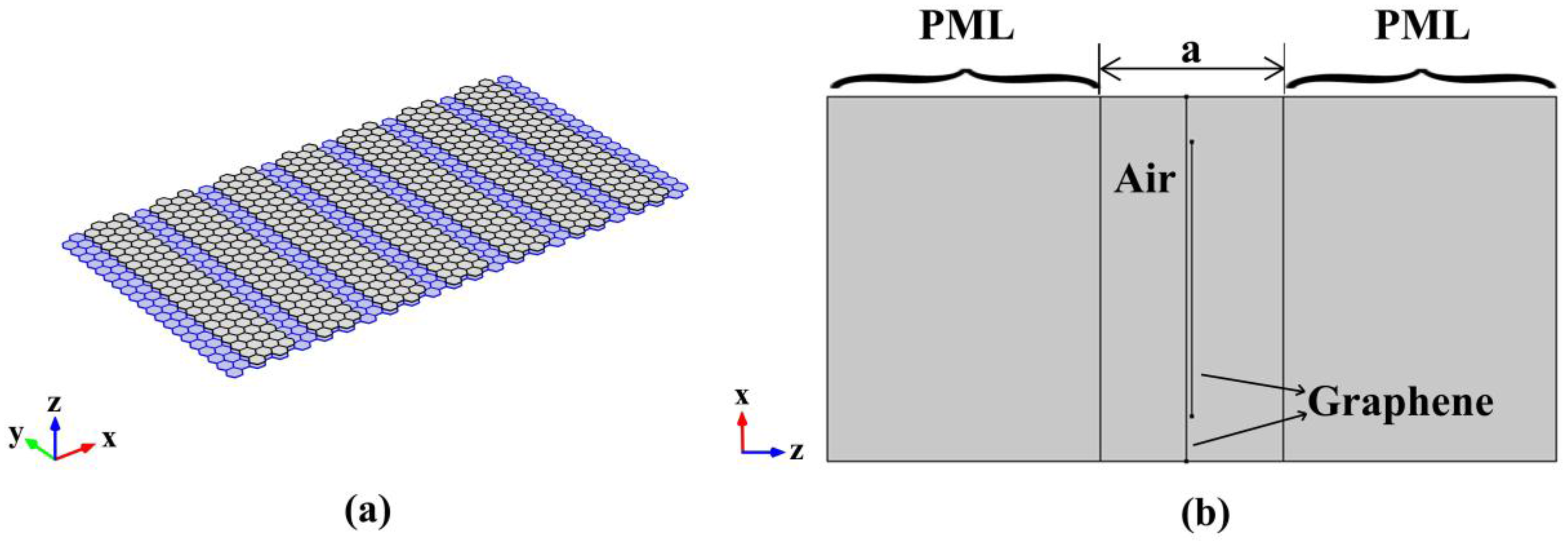

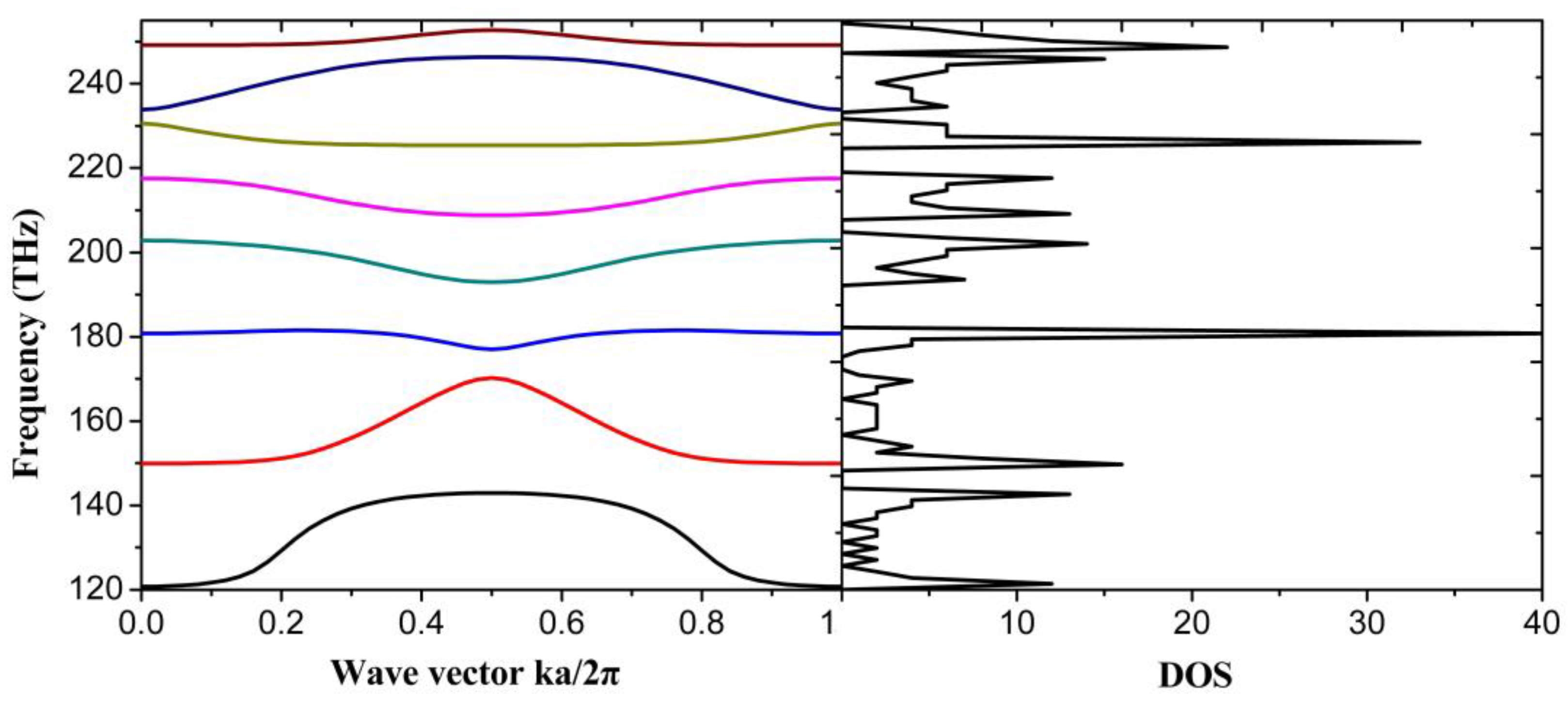
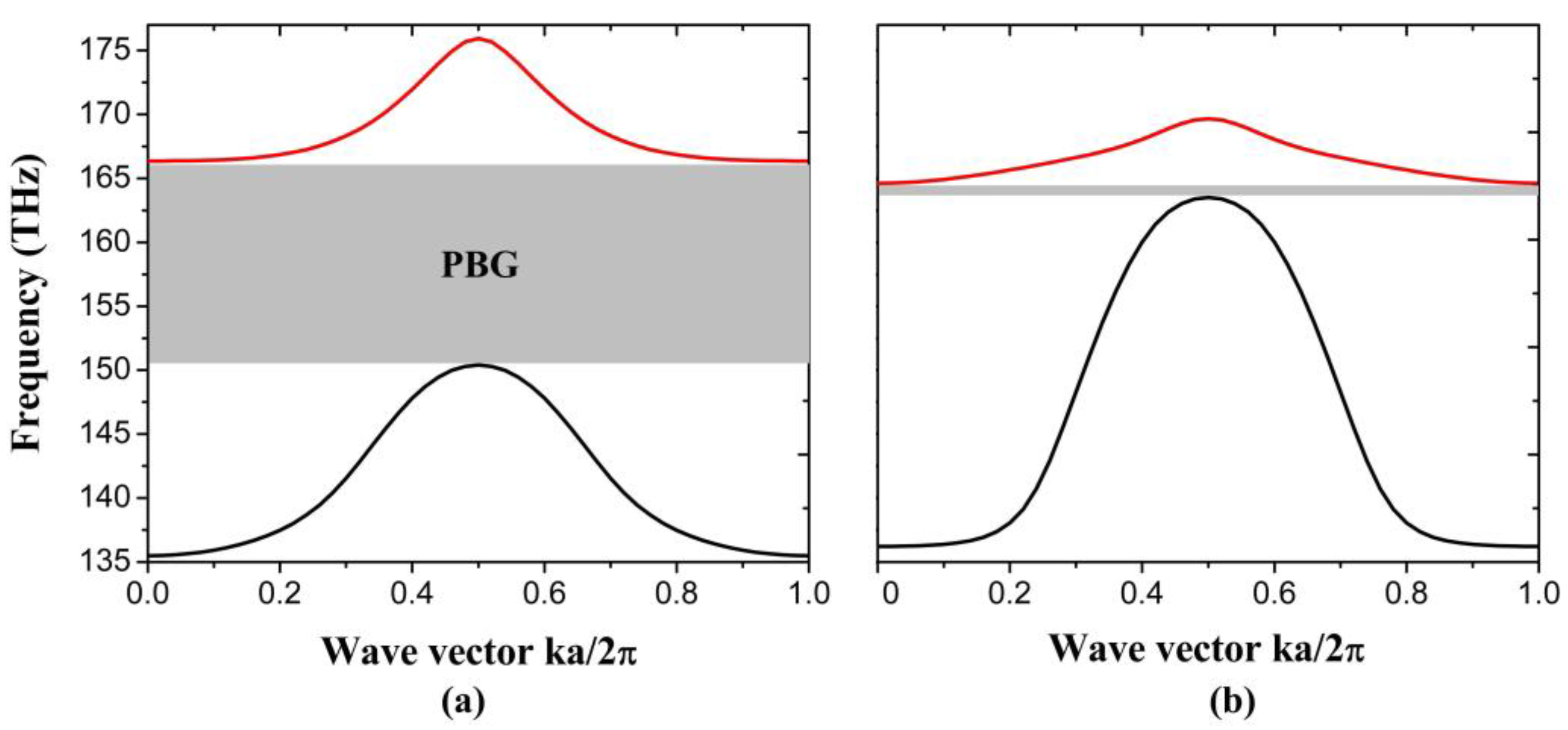

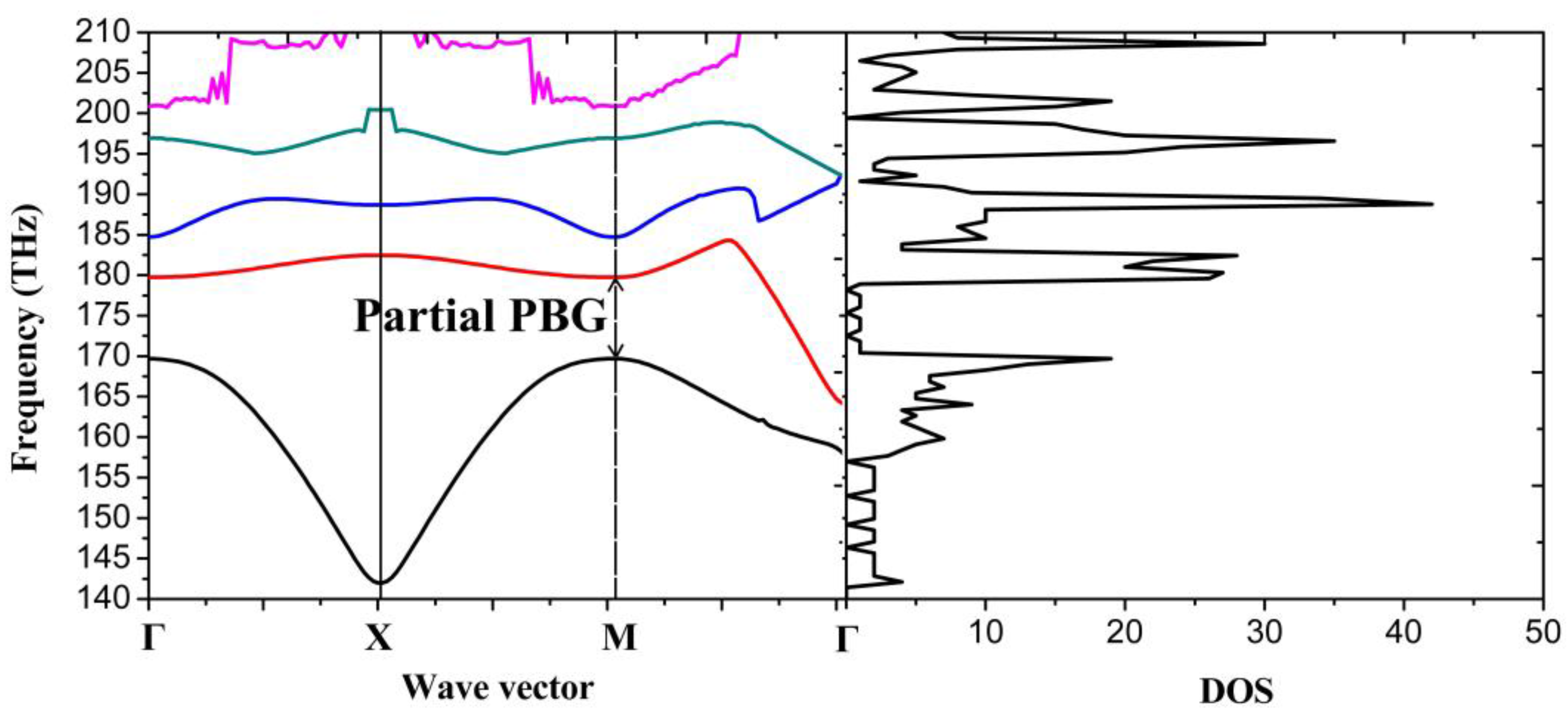
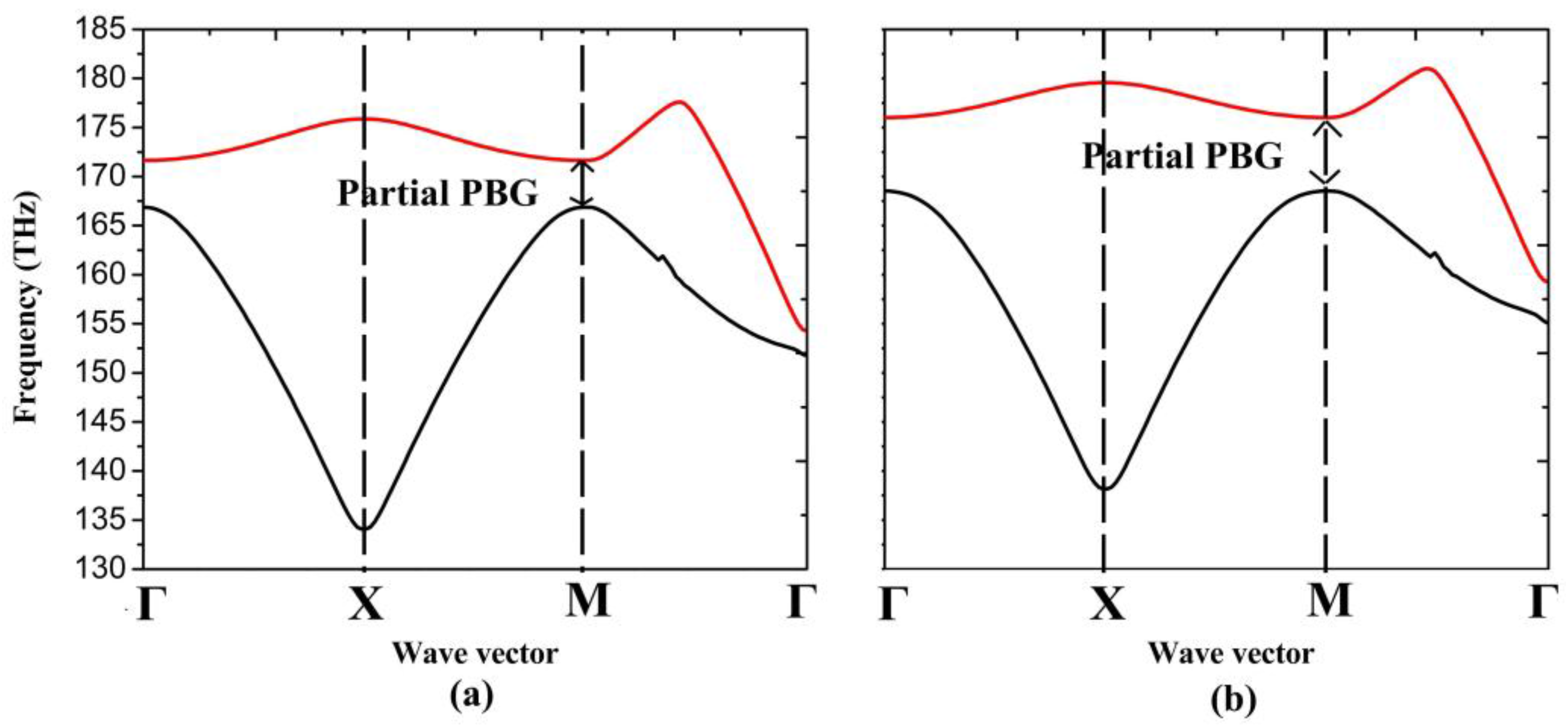

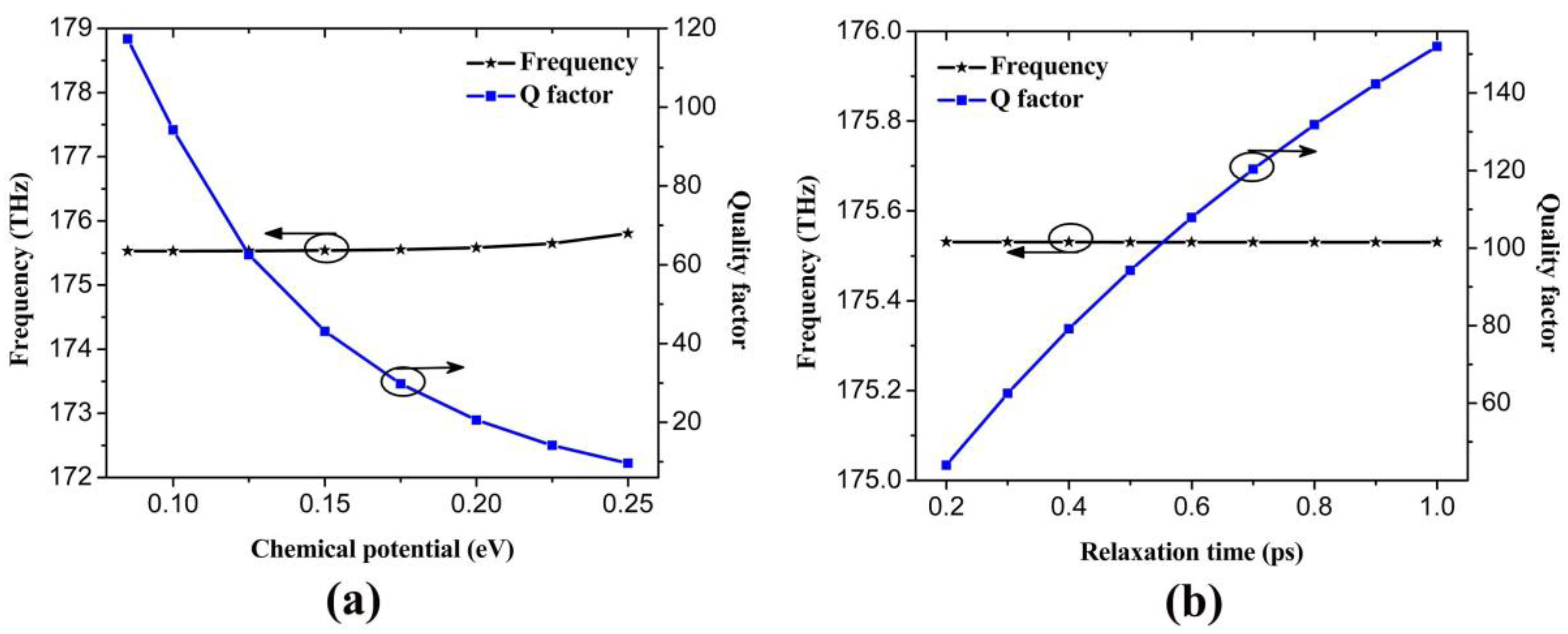
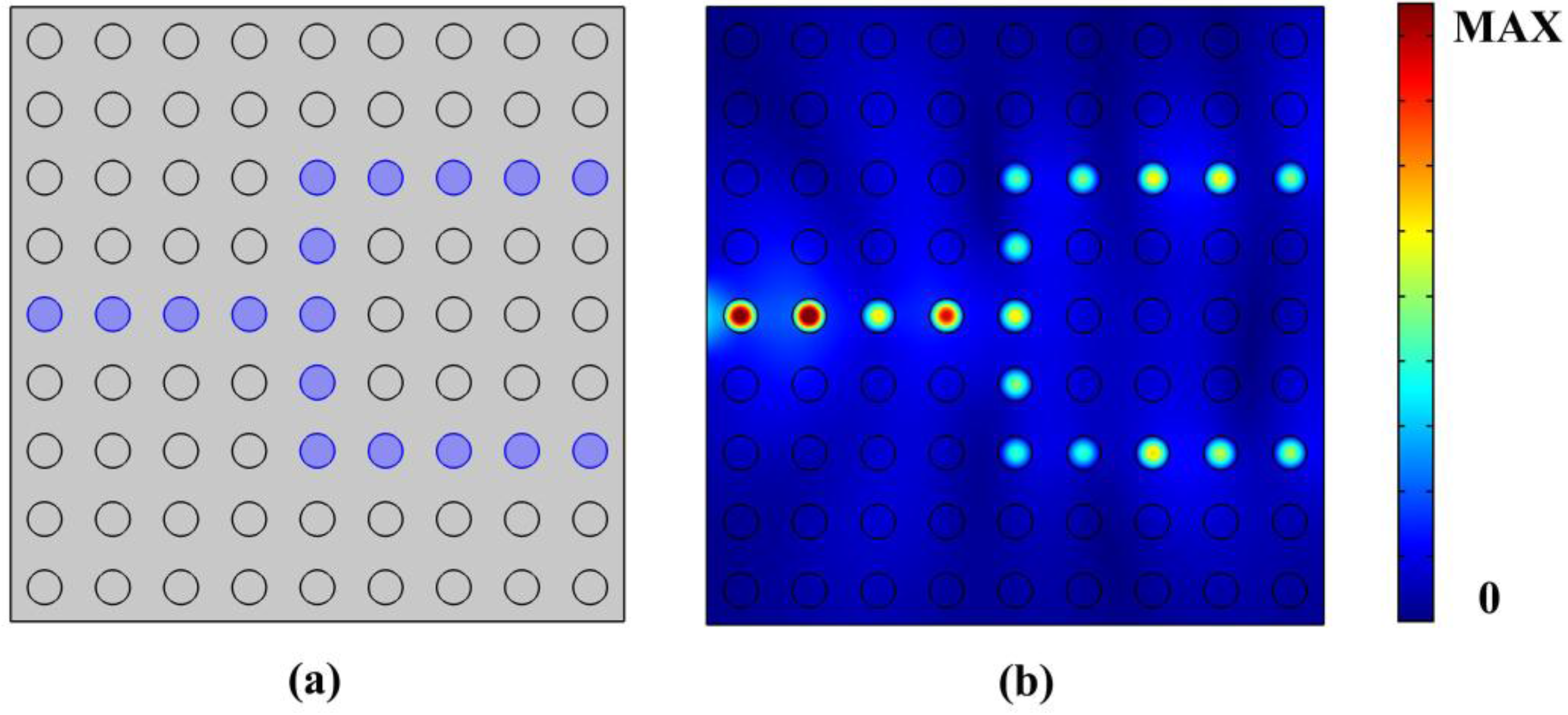
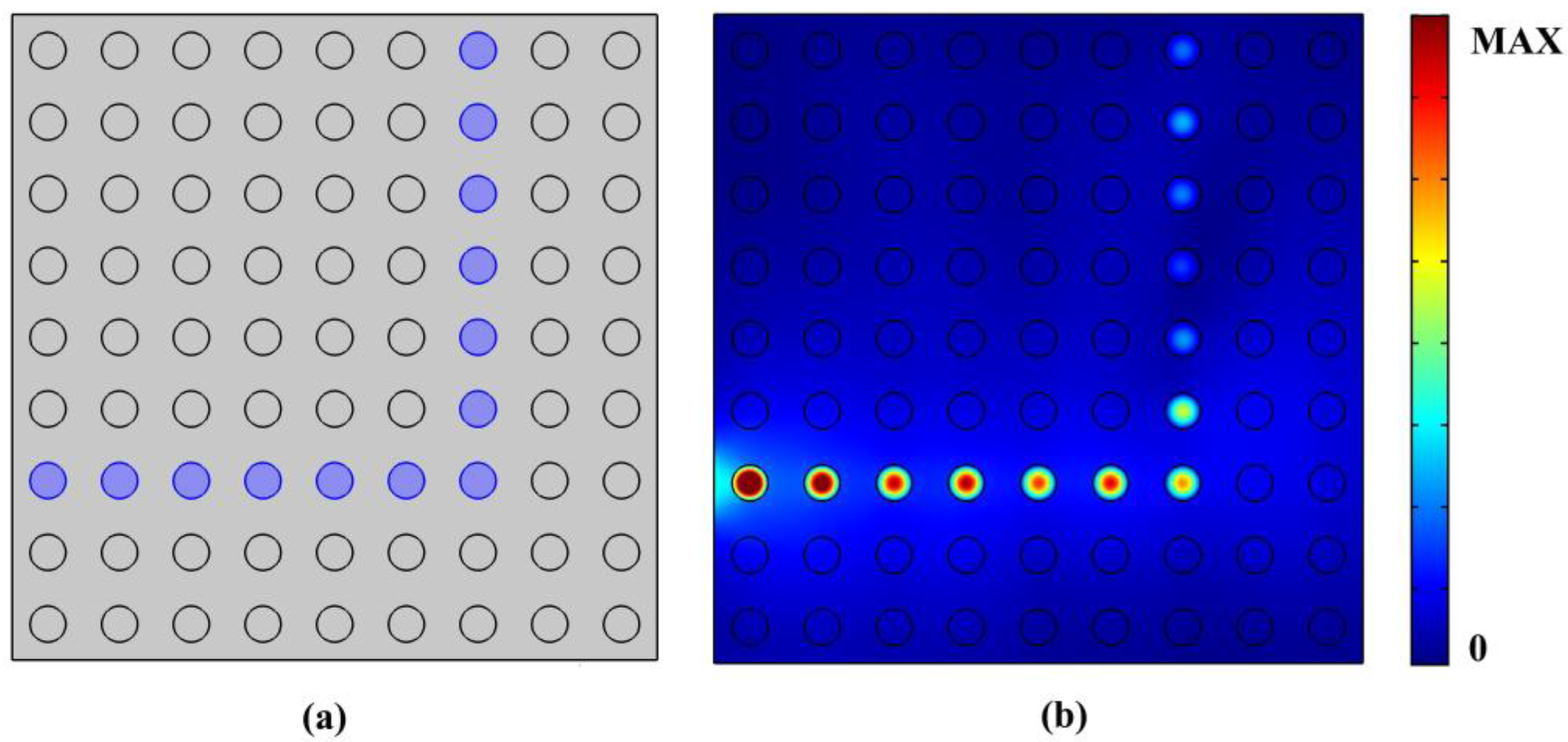
© 2016 by the authors; licensee MDPI, Basel, Switzerland. This article is an open access article distributed under the terms and conditions of the Creative Commons Attribution (CC-BY) license (http://creativecommons.org/licenses/by/4.0/).
Share and Cite
Qiu, P.; Qiu, W.; Lin, Z.; Chen, H.; Tang, Y.; Wang, J.-X.; Kan, Q.; Pan, J.-Q. Investigation of the Band Structure of Graphene-Based Plasmonic Photonic Crystals. Nanomaterials 2016, 6, 166. https://doi.org/10.3390/nano6090166
Qiu P, Qiu W, Lin Z, Chen H, Tang Y, Wang J-X, Kan Q, Pan J-Q. Investigation of the Band Structure of Graphene-Based Plasmonic Photonic Crystals. Nanomaterials. 2016; 6(9):166. https://doi.org/10.3390/nano6090166
Chicago/Turabian StyleQiu, Pingping, Weibin Qiu, Zhili Lin, Houbo Chen, Yixin Tang, Jia-Xian Wang, Qiang Kan, and Jiao-Qing Pan. 2016. "Investigation of the Band Structure of Graphene-Based Plasmonic Photonic Crystals" Nanomaterials 6, no. 9: 166. https://doi.org/10.3390/nano6090166





